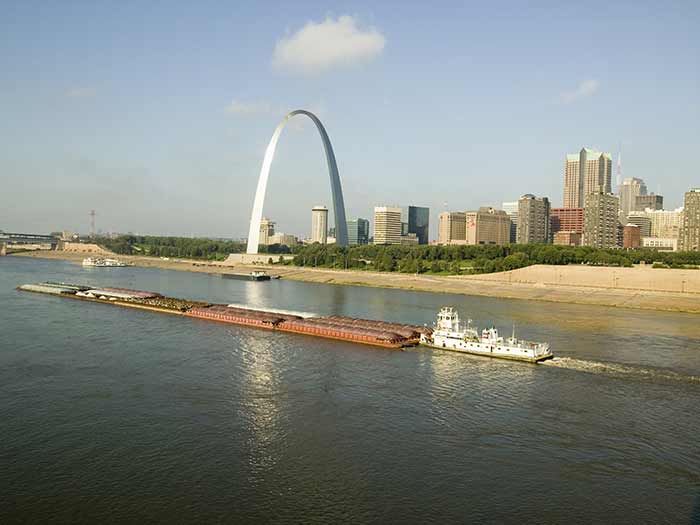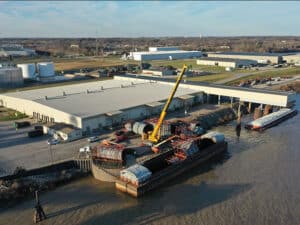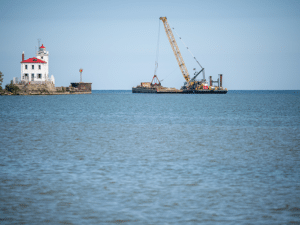
Historic low-water conditions continue to impact Mississippi River traffic
Written by Heather Ervin
Shutterstock
An update to this story can be found here.
Impacts to navigation not seen since 1988 continue as low Mississippi River water levels linger. These impacts include barge groundings, lock closures and river cruise cancellations.
According to the National Oceanic Atmospheric Association (NOAA), drought and abnormal dryness continue to develop and intensify from the Plains through the Mississippi River Basin, and have now extended further into the Midwest and Southeast. Low water levels are impacting barge traffic on the Mississippi River during the harvest, a crucial time. As of October 4, 2022, 44.04% of the U.S. and 52.55% of the lower 48 states are in drought.
In response to the drought, American Commercial Barge Line (ACBL) issued statements in its American Currents newsletter that the maritime industry is expecting catastrophic impacts to towboat capacity, which will in turn, drastically decrease ton-mile productivity for the inland rivers.
ACBL said that it is working to crew all available boats and mobilize equipment to combat these conditions.
U.S. Coast Guard Sector Lower Mississippi River recently reported eight groundings in the past week due to low water levels.
One of the barge groundings happened September 30 near Lake Providence, La., where it halted river traffic in both directions for days, according to the U.S. Army Corps of Engineers. The grounded barges have been cleared and dredging is deepening the channel to prevent future groundings.
The U.S. Department of Agriculture’s Grain Transportation Report released September 29 said that 1,890 grain barges have unloaded in New Orleans since September 1, about 39% fewer than the five-year average.
Barge companies have to load barges lighter in order to prevent groundings, which have already occurred and are a growing concern, according to Mike Steenhoek, executive director of the Soy Transportation Coalition. A typical barge can be loaded with 1,500 short tons of freight (50,000 bushels of soybeans). A 15-barge tow can therefore easily accommodate 750,000 bushels of soybeans. Each reduced foot of water depth (i.e. “draft”) will result in 150-200 fewer short tons (5,000-6,700 fewer bushels of soybeans) being loaded per barge.
DROUGHT CONDITIONS WORSEN
According to the Drought Mitigation Center, over 90% of the Missouri River Basin is currently experiencing some form of abnormally dry conditions or drought, which is almost a 20% increase from the end of August.
“Runoff in the upper Missouri River Basin was below average during the month of September and is expected to remain low throughout the rest of 2022,” said John Remus, chief of the U.S. Army Corps of Engineers’ Missouri River Basin Water Management Division.
“Releases from Gavins Point Dam will continue to be set to maintain a service level 500 cubic feet-per-second above the minimum service level,” Remus added.
The 2022 calendar year runoff forecast for the upper Basin, updated on October 1, is 19.5 MAF, 76% of average and 0.7 MAF lower than last month’s annual runoff forecast. Average annual runoff for the upper Basin is 25.7 MAF.
Total System storage as of October 5 was 48.5 MAF, which is 7.6 MAF the base of the flood control zone. Due to the extremely dry conditions in the upper Missouri River Basin, the system is expected to lose an additional 2.0 MAF before the 2023 runoff season begins in March of 2023.
Due to the scarcity of precipitation throughout the year, the water depth along our navigable waterways is limiting the efficiency of barge transportation in two ways—channel depth and channel width. Currently, the area of particular concern is the Mississippi River south of St. Louis.
Late last week, the St. Louis Engineer District said that it has been monitoring low water levels along the Mississippi River.
As of September 28, there were no restrictions in the navigation channel north of Cairo in the district’s area of operations and the authorized depth of nine feet is being maintained with assistance from dredging.
“Based on a 28-day forecast, we do not see any areas where our dredging operations will not keep up with the forecasted falling river stages,” said Lou Dell’Orco, chief of operations.
“In addition to the Dredge Potter, we have the Dredge Jadwin from the Vicksburg District working the lower end of the Mississippi and we are using the Dredge Goetz from the St. Paul District to address the Illinois Waterway,” he continued. “The St. Louis District has also utilized the Louisville District’s contract dredge Bill Holman.”
In addition to actively dredging the river to keep the channel open, the water management office is closely monitoring the current conditions and forecasting future conditions.
On October 3, the New Orleans Engineer District closed Harvey Lock at the mouth of the Harvey Canal where it enters the Mississippi River “due to risk from reverse head conditions as a result of low water levels on the Mississippi River.”

RIVER CRUISE HALTED
Not only is the low water affecting barge traffic, threatening U.S. agricultural exports, but it’s also causing issues for the river cruise business, including for Viking River Cruises newly introduced Viking Mississippi.
In a statement released by Viking on October 5, the company said that unusually low water levels along the Mississippi River have caused sections of the river to be closed, impacting all northbound and southbound shipping traffic.
“The U.S. Army Corps of Engineers is working to deepen the shipping canal in some sections, but the closures have caused delays that will prevent the Viking Mississippi from completing the sailing underway and from reaching St. Paul (Minn.) for her next scheduled departure on October 15.
“All impacted guests and their Travel Advisors, if necessary, have been notified directly. At this time, we expect to operate all future departures of the Viking Mississippi as scheduled.”




